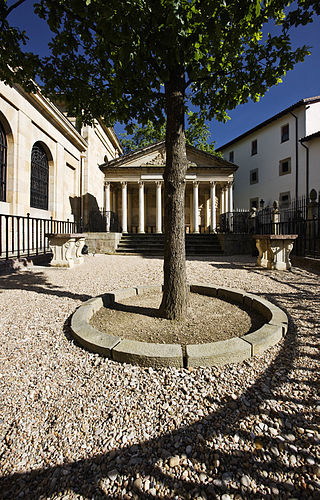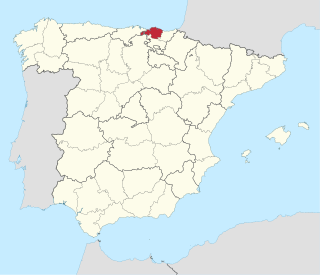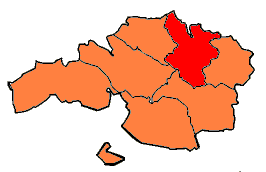
Guernica, officially Gernika in Basque, is a town in the province of Biscay, in the Autonomous Community of the Basque Country, Spain. The town of Guernica is one part of the municipality of Gernika-Lumo, whose population is 16,224 as of 2009.

Biscay is a province of Spain and a historical territory of the Vascongadas, heir of the ancient Lordship of Biscay, lying on the south shore of the eponymous bay. The capital and largest city is Bilbao.

Eibar is a city and municipality within the province of Gipuzkoa, in the Basque Country of Spain. It is the capital of the eskualde / comarca of Debabarrena.

Gipuzkoa is a province of Spain and a historical territory of the autonomous community of the Basque Country. Its capital city is Donostia-San Sebastián. Gipuzkoa shares borders with the French department of Pyrénées-Atlantiques at the northeast, with the province and autonomous community of Navarre at east, Biscay at west, Álava at southwest and the Bay of Biscay to its north. It is located at the easternmost extreme of the Cantabric Sea, in the Bay of Biscay. It has 66 kilometres of coast land.

Ziortza-Bolibar is a municipality in the province of Biscay, Basque Country (Spain), in the comarca of Lea-Artibai. It has 383 inhabitants according to the 2006 census, and has an area of 18.94 km2.

Elgoibar is an industrial town located in the province of Gipuzkoa, in the Autonomous Community of the Basque Country, northern Spain. Located in a valley, it is traversed by the Deba river. Elgoibar is nicknamed the "capital city of the Machine tool".

Mutriku is a coastal town located in the province of Gipuzkoa in the Autonomous Community of Basque Country in northern Spain. It has a population of around 5000 and provides access to the Bay of Biscay. It is the site of the world's first multi-turbine breakwater wave power station, opened July 8, 2011. The Church of San Andrés can be found here, being one of the oldest churches in Gipuzkoa, dating to the year 1080.

Berriatua is a town and municipality located in the province of Biscay, in the autonomous community of the Basque Country, in the north of Spain. Its neighbors are Ondarroa and the Bay of Biscay to the north, Markina-Xemein to the south, Mutriku to the east, Amoroto and Mendexa to the west. Historically Berriatua was a town of farmers with little industry. Recently the town has seen significant industrial growth as well as a great deal of construction.

Elorrio is a town and a municipality located in the eastern part of the province of Biscay, in the Basque Country, in northern Spain. As of 2017, it has a population of 7,307 inhabitants. It covers an area of 37.20 square kilometers and it has a population density of 193.58 people per square kilometer. It holds the medieval title of Most Loyal and Noble Villa.
Goierria-Ziortza is a Spanish town within the municipality of Markina-Xemein, in the province of Biscay, in the autonomous community of Basque Country.

Mallabia is an elizate, town and municipality located in the province of Biscay, in the Basque Country, northern Spain. Mallabia is part of the comarca of Durangaldea and has a population of 1.135 inhabitants as of 2006 and according to the Spanish National Statistics Institute.

Mañaria is an elizate, town and municipality located in the province of Biscay, in the Basque Country, Spain. Mañaria is part of the comarca of Durangaldea and has a population of 459 inhabitants as of 2006 according to the Spanish National Statistics Institute.

Lea-Artibai is an eskualdea/comarca of the province of Biscay (Bizkaia), in the Basque Country, Spain. Lea-Artibai is the heir of the historical merindad of Markina, which was one of the merindades of Biscay. Currently, Lea-Artibai is one of the seven comarcas that compose the province. Its capital city is Markina-Xemein.

Mount Oiz, is one of the most popular summits of Biscay in the Basque Country (Spain). Its summits form part of a long range that feeds several rivers: Ibaizabal, Artibai, Lea, Oka and Deba in Gipuzkoa all of them running to the Bay of Biscay.

Busturialdea, also named Busturialde - Urdaibai is a comarca of the province of Biscay, in the Basque Country, Spain. It is the heir of "Busturia", one of the original merindades that used to compose the province of Biscay – this should not be confused with Busturia, a municipality located in this region. Busturialdea is a diminished portion of the same original subregion and has two capital cities; Bermeo and Gernika-Lumo. It is one of the seven comarcas that compose the province of Biscay.

The Lordship of Biscay was a region under feudal rule in the region of Biscay in the Iberian Peninsula between c.1040 and 1876, ruled by a political figure known as the Lord of Biscay. One of the Basque señoríos, it was a territory with its own political organization, with its own naval ensign, consulate in Bruges and customs offices in Balmaseda and Urduña, from the 11th century until 1876, when the Juntas Generales were abolished. Since 1379, when John I of Castile became the Lord of Biscay, the lordship was integrated into the Crown of Castile, and eventually the Kingdom of Spain.

The autonomous community of the Basque Country within Spain contains several comarcas or eskualdeak in the Basque language, referring to local districts, grouped into its three long-established provinces.
Nicolasa Pradera (1870–1959) was a Basque chef, restaurateur, and is most known for her cookbook "La cocina de Nicolasa", which is one of the staples of Basque cooking.
The Biscay autonomous football team was the regional football team for the province of Biscay, Spain, active between the 1910s and the 1930s. They were never affiliated with FIFA or UEFA, because Biscay is represented internationally by the Spain national football team.




















